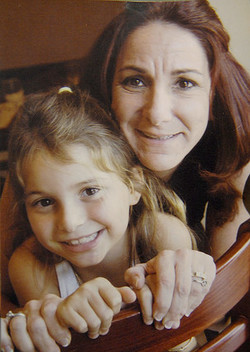
By Kevin Deutsch and Sasha Gonzales
[email protected], [email protected]
Nancy Bochicchio was a Bronx girl through and through: generous, hard-working, street smart—the kind of local that makes her borough proud.
Her daughter, Joey, was raised in the same mold: savvy and strong, a Florida-reared girl with a “New York attitude.” The 7-year-old, it was plain to see, took after her mother.
Nearly a dozen years ago – roughly 1,260 miles from the Bronx neighborhood where Nancy grew up – the Bochicchios were murdered in shocking fashion, shot in their heads at point blank range in December 2007 after going Christmas shopping at Town Center, an upscale mall in Boca Raton, Fl.
The crimes – among the most disturbing murders ever committed in modern-day South Florida, and part of a series of abductions and killings of mall patrons that year – had an outsized impact in New York, where the rest of the Bochicchio family, and some of Nancy’s friends, still reside.
The slain mother and daughter weren’t the only victims with roots in New York City; Randi Gorenberg, a Brooklyn-born mother of two, was abducted and slain in March 2007 after an afternoon of shopping at the same mall. Last seen on surveillance footage exiting the posh retail property, Gorenberg wasn’t seen in public again until half an hour later, when shocked witnesses watched her being fatally shot and tossed from the passenger side of her new Mercedes SUV.

Her killer, or killers, got away.
Another mother and her 2-year-old-son were also kidnapped, taken from the same mall before the mother was ritualistically bound with goggles and zip ties in August of 2007—the same year as the other attacks.
Their abductor later returned them to the mall, where he left both victims – terrified but alive – inside the mother’s luxury SUV.
The 2007 abduction and murder spree spurred authorities to offer the largest reward in Florida’s history.
Yet the crimes continue to baffle investigators from the FBI, Boca Raton Police, and Palm Beach County Sheriff’s Office. Whether the same attacker or attackers carried out all the abductions and murders, or whether different criminals committed them, remains unclear.
The crimes, too, remain shrouded in secrecy, with thousands of investigative records compiled by law enforcement agencies shielded from public review, due in part to an “active investigation” exemption in Florida’s otherwise expansive public records law.
But a trove of records obtained by Bronx Justice News is shedding new light on the mall attacks, revealing previously unknown details about detectives’ pursuit of the killer or killers, the lives of the victims, and security lapses at Town Center at Boca Raton mall in the lead-up to the abductions and murders.
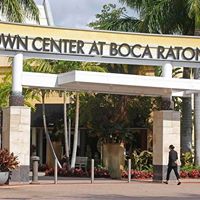
New Details in Gorenberg Probe
Among the never-before-reported revelations from the Gorenberg investigation, and included in the documents:
Palm Beach County Sheriff’s Office detectives have collected numerous DNA samples for testing in the Gorenberg case, hoping to match them with the unknown person’s DNA found in Randi’s SUV after her murder.
Among those who’s genetic material was tested but did not match the sample from the SUV are at least eight friends and associates of Gorenberg’s son, Daniel, all of them named in the documents. Each submitted to DNA tests in the months after Randi’s killing, according to the records, which were turned over by the Palm Beach County Sheriff’s Office as part of husband Stewart Gorenberg’s lawsuit against Town Center.
Among those who provided a non-matching genetic sample was Courtney Smith, a friend of Daniel’s who told detectives Daniel “had stolen her deceased mother’s jewelry and pawned it.” Another friend of Daniel’s, Sara Firestone, told detectives “she recalls the day of the murder that Sean Kushner and Daniel Gorenberg were trying to sell a ring but she couldn’t recall the type.”
Still another friend, Genevieve Handler, told detectives Daniel “had given her a woman’s diamond ring and then asked for it back and told her not to say anything to his father. She also believes the [killer] may be one of Daniel’s drug type friends because of his drug addiction.” The morning of his mother’s murder, another friend of Daniel’s told detectives, she obtained Xanax for herself and Daniel—then split the pills with him.
Daniel Gorenberg was arrested for allegedly trying to fraudulently obtain prescription drugs in Delray Beach in August 2007. The charge was later dropped as part of an agreement with prosecutors and the court. Daniel’s father, Stewart Gorenberg, had also faced charges of alleged insurance fraud pertaining to his chiropractic practice. Those charges were later dropped, too, and neither man was convicted of any crimes in their respective cases.
Daniel and Stewart Gorenberg could not immediately be reached for comment for this article.
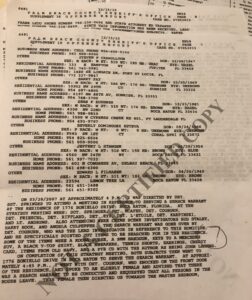
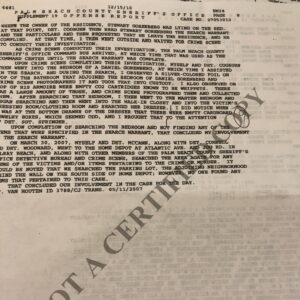
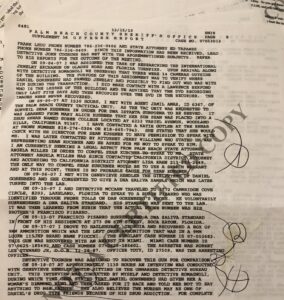
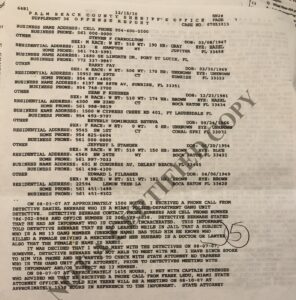
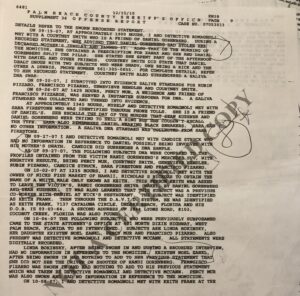
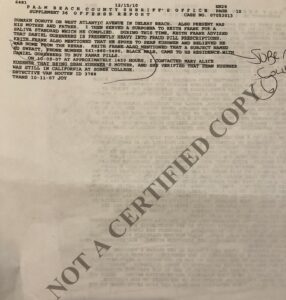
Friend Entered Rehab After Murder
Detectives requested that Sean Kushner – a friend of Daniel’s who investigators honed in on following interviews with Daniel’s associates – be placed under surveillance by the PBSO tactical unit in September 2007. Detectives hoped a subpoena for collection of Kushner’s DNA could be issued and served, so that his DNA could be compared with the genetic material found in Randi Gorenberg’s SUV, the records show.
Kushner’s mother told detectives her son was “placed into a drug rehab named Sober College”; a now shuttered facility formerly located in Woodland Hills, California. Detectives tried to reach Kushner, and were later contacted by an attorney named Jerry Williams “who stated he was representing [Kushner] and he asked for me not to speak to him,” wrote now-retired PBSO cold case Detective John Van Houten.
Palm Beach County prosecutors then reached out to their counterparts in California, who told them “the only way to compel [Kushner] would be to use a search warrant and at this point, there is no probable cause for Sean Kushner.”
It is not clear whether Kushner ever provided a DNA sample to investigators. He could not immediately be reached for comment.
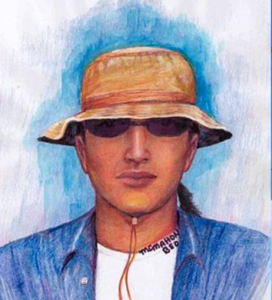
PBSO detectives tried to obtain surveillance footage from the International Jewelers Exchange on Glades Road, to verify whether Daniel Gorenberg or others had pawned jewelry there. But DVD recordings from the building’s 14 cameras were copied over after five days.
“The images were never recovered,” Van Houten wrote.
At a strategy meeting held before detectives served a search warrant at Randi and Stewart Gorenberg’s home, some of the specific items investigators said they would look for were Randi’s Koba purse, a nine-millimeter handgun, keys to her and Stewart’s Mercedes SUV, a black tank top, black sneakers (Firestone had told detectives Daniel wore black sneakers the day of his mother’s murder) tennis shorts, earrings, credit cards, and items Randi had purchased from the Old Navy and FYE stores at Town Center, including a John Legend CD.
Later, while searching Randi’s dresser, Van Houten “did notice when I was at the bottom drawer of that dresser that there were empty cardboard jewelry boxes, which seemed odd, and I brought that to the attention of Det. Sgt. Springer,” head of the PBSO cold case unit.
None of the items mentioned in the search warrant, including the black sneakers, were found inside the home.
During a deposition in the Gorenberg civil suit, which was later settled for an undisclosed amount, a lawyer asked Springer how frequently Stewart Gorenberg visited prostitutes.
“It varied over the years,” Springer said. “Prior to his wife’s death, about twice a week.”
Later, the lawyer asked Springer whether Gorenberg “continued to interact with prostitutes” after Randi’s killing.
“I know that he contacted one after his wife’s death,” said Springer, who said he had personally interviewed prostitutes who interacted with Stewart Gorenberg.
“Can you tell me how soon after his wife’s death that he contacted this particular prostitute?” the lawyer asked.
“I would have to look at the records,” Springer said. “I don’t recall. It was within a month or two months.”
Detectives learned of Stewart’s visits to a massage parlor – which they characterized as a place of prostitution – through surveillance conducted after Randi’s death.
Springer said he had no evidence that Stewart Gorenberg’s liaisons with prostitutes were connected to his wife’s killing.
Husband ‘Not Eliminated’ as Suspect
Asked by a Simon Malls attorney whether Stewart had been eliminated as a suspect in his wife’s murder, Springer said: “I’m comfortable with [saying] he has not been eliminated as a suspect, no.”
“If we had evidence establishing the fact that Mr. Gorenberg was responsible for his wife’s death, he would be arrested for it today,” Springer said. “Put it that way.”
“And from the point you became involved through today at least, there is no such evidence that you have been able to develop?” the mall attorney asked.
“I’m not going to answer that question,” Springer said.
Later, the lawyer asked: “Is there any forensic evidence that excludes the possibility that he might have killed his wife?”
“Let’s put it this way,” Springer said. “There is no forensic evidence at this point that either brings him in or eliminates him.”
Possible Links Between Killings
Asked whether the Gorenberg and Bochicchio cases, along with the non-fatal mall abductions, might be linked, Springer said: “We have never closed that door. There is no forensic evidence as I’ve stated, but we have always kept that door open, that there is a possibility that they are all connected, yes.”
New Details in Bochicchio Probe
Among the never-before-reported revelations from the investigation into the abduction and murders of Nancy and Joey Bochicchio, and included in the documents:
Nancy’s sister, JoAnn Bruno, gave hours of moving testimony in her civil case against Town Center owner Simon Malls, which was later settled for an undisclosed amount.
At one point, Bruno interrupted her deposition to hand photos of Nancy and Joey to Jack Lucks, an attorney representing Simon Malls, “so when you are working on this you will remember that they are people. It’s not just a case.”
“I’m sorry, I have to show you these,” Bruno said. “I have to get them out.”
“Sure,” Lucks said.
“They were people,” Bruno said. “I know to you this is a case.”
“Well, let me—”
“These are real people that were loved.”
Later, she told Lucks: “You can’t understand. It was her birthday, her last birthday…. no eight-year-old should have a birthday in heaven.”
“These are real things. And you know what I have left? The teeth that fell out of Joey’s mouth when she lost her first tooth and the second tooth. I have her precious little teeth. And these pictures. And nothing more.”
Bruno said she spoke to the lead investigator on the case, Boca Raton Police Captain Matthew Duggan, “every few weeks. And you know, he tells me ‘nothing new.’”
“I have had meetings with…FBI and everybody. I get called in for meetings. And there are things I ask and they tell me that it’s an open case and I can’t be told. I get a lot of those answers which is not very satisfying. But I understand.”
In response to a federal freedom of information request for documents pertaining to the mall cases, the FBI – whose vaunted criminal profilers have investigated the Boca killings – said it would not release any records, citing an ongoing investigation.
Of the emotional fallout from the murders, Bruno said: “I will never be all right…. the person I loved the longest in this world and she was taken from me brutally, in no time at all.”
“I spoke to her just before it and then she was gone. My little angel was going to be a reindeer the next night in the Christmas play,” Bruno said of Joey. “Instead she was an angel in heaven. I wasn’t okay after that. That was not God’s will.”
“Her eighth birthday I bought her a coffin. You live with that one.”
“And I promised my mother and father I would take care of them….and I wasn’t with them. I was always with them. I wasn’t there that day. I didn’t get to take care of them. [Nancy] went to the mall to buy a gift for Christmas.”
Bruno said her sister told her she was going to Town Center to buy a Christmas gift for her friend’s niece.
“She asked me, you know, what to get. It was a teenager. So, I figured a gift card was the best.”
“She was getting a gift card at [Club Libby Lu].”
“And you also said she was buying something for a teenage girl,” Lucks asked Bruno during her deposition. “Do you know the teenage girl or the teenage girl’s mother that Nancy was buying the gift for?”
“Yes. It was a friend of my sister’s. But I wouldn’t dare tell her why she went. She never knew. I mean, I couldn’t lay that guilt on the girl that she was going to the mall for her daughter. So, this girl never knew.”
Bruno said of Joey: “She had such a promising future. She was a brilliant child and not because she was mine. She would go to Mizner Park and walk in the restaurant. And as soon as they saw her they would say ‘a dozen oysters.’ I mean, everybody knew her everywhere. They used to call her ‘The Little Boca Mayor.’ She had a personality like gold.”
And my sister lived for her, literally. She always wanted a child. They told her she would never have one. That’s why she had one so late. They told her she wouldn’t have one.”
And a New York hospital told her to have an abortion because she was going to be born deformed and every other problem.”
And my sister turned around and said…to the doctors ‘this angel needs me more than any other child, I will not abort it.’ That’s how much she wanted her. And that’s how important she was. When she was born she was a bubbling, nine-pound baby. Gorgeous, adorable. This is not just a case. These are my babies. And they left me.”
Security Lapse at Town Center
Records filed as part of the lawsuits show dozens of crimes were committed at Town Center before the 2007 murders and abductions. Most of those crimes were never disclosed to the public.
“During the 36 months prior to the abduction and murder of Randi Ann Gorenberg, the reported criminal incidents at the subject property included: a) 43 automobile thefts of attempted thefts; b) 93 burglaries from vehicles or attempted burglaries; c) 54 incidents of vehicle vandalism; d) 25 thefts from vehicles; e) 10 bike thefts; f) 20 robberies, 5 of which were armed; g) 15 strong arm/purse snatches; h) 23 pickpockets; i) 43 drug possession/paraphernalia/sales; j) 7 incidents of carrying concealed weapons; k) 6 indecent exposures; l) 24 incidents of battery; m) 3 aggravated assault/battery; n) 6 incidents of disturbance/fights o) 38 incidents where people were injured during crimes; and p) 20 incidents where weapons were confiscated,”records filed in the Gorenberg civil case show.
Over 10 million shoppers visited Town Center mall annually, including more than 27,000 a day, at the time of the 2007 attacks. But the ten private security officers on duty the day of Gorenberg’s killing failed to check-in at nearly all of their required security “checkpoints,” and no record exists of a single guard patrolling zone 4 – the zone where Randi Gorenberg was last seen – at all from 9:50 am to 7:22 pm on the day of her killing, the court records show.
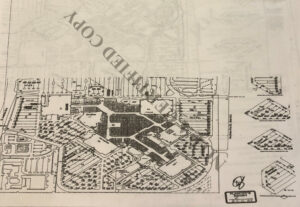
The security system used by Town Center security officers at the time of the abductions and murders was called “D3 Guard Tour,” a mobile system in which a handheld computer is used by guards to record incident data, scan checkpoints, and view dispatch notes while performing their duties in the field, the records show.
If used correctly, the devices were supposed to help identify crime hotspots, effectively allocate resources, manage security assets, and improve security.
As they arrived at work each day, each security guard would receive a handheld computer, which identified the specific patrol zones they were assigned during their shift.
Each patrol zone had a call box, which contained a small sticker with a “site specific barcode.” The security officers were required to scan those barcodes when they arrived.
Zone 4, the location where Gorenberg was last seen walking, contained 99 separate checkpoints with site specific codes, according to court records. These included exterior parking and interior landmarks, like an elevator at Bloomingdales and a vending machine outside Pottery Barn.
Zone 4, at the time, encompassed all Town Center parking areas from the northwest corner of Sears to the southeast corner of Bloomingdale’s. It was the largest geographical area among the zones handled by mall security, and appeared to go largely unpatroled the day of Randi’s killing, the records show.
Between March 18 and March 31, less than 1 percent of “exterior zones” – those in Town Center’s outdoor parking areas – were patrolled by mall security, according to records filed in the Gorenberg civil suit.
“There were no security guards patrolling zone 4 or surveillance cameras that could record footage of her and/or her assailant(s) as she was abducted,” Stewart Gorenberg’s lawyers wrote. “Zone 4 was not being patrolled or monitors and therefore, provided the optimal location where a crime like this could take place without the threat of being caught.”
Security improvements were supposed to be made at the mall before the 2007 abductions and killings, but did not get done until after the murders.
“On or about June 8, 2006 Defendant Simon entered into a contractual agreement with IPC International-Technical Division for consultation for security services,” according to court records. “The contract was to be performed between July 1, 2006 and August 15, 2006 and called for an initial site review with recommendations for physical and technical improvements, updates, corrections, and/or solutions toward current and future security concerns….The initial site did not occur and recommendations were not received.”
Abducted Victim Took Polygraph
The 31-year-old woman who was abducted along with her son in the Town Center parking lot on Aug. 7, 2007, gave testimony as part of her own lawsuit against Simon Malls.
The woman, identified in court records as “Jane Doe,” said investigators from the Boca Raton Police Department initially accused her of lying about being kidnapped, and asked her to take a polygraph.
“Detective Juan Pijuan was the main detective,” she said in her deposition. “There was the guy who gave the polygraph. I don’t know his name. And then the other detective that did the ride-around” re-visiting the locations she and her son were taken to after being abducted.
Of the detectives who questioned her, Jane Doe said: “They told me I was lying. Why am I lying.”
The armed abductor, wearing a gun holster and driving gloves, had bound Jane Doe’s limbs with zip ties during the attack. He also covered her eyes with blacked out goggles or sunglasses, just as he did to Nancy Bochicchio.
Investigators believe the same man carried out both attacks, but are uncertain whether there is any connection to Randi Gorenberg’s murder—or to an armed robbery that occurred at Mizner Park on Aug. 10, 2007.
Boca police made no mention of the zip ties, goggles, gloves, or holster in the short press release they issued after the Aug. 7 attack, nor did they characterize the armed kidnapping from mall property as an abduction.
The attack came about four-and-a-half months after Randi Gorenberg’s murder, and about four months prior to the Bochicchios.’
The Yellow Goggles
Boca Raton Police in 2010 asked the public for help in identifying the manufacturer, retailer and point-of-sale for the black and yellow goggles used in the attack on the Bochicchios. Authorities previously described them in the press as a variety of aquatic goggles.
They are, in fact, motorcycle goggles, retailers and motorcyclists say.
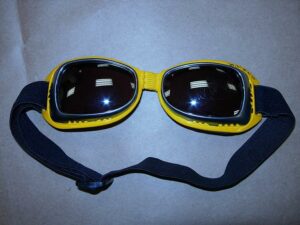
While the exact model used by the killer has not been sold by online purveyors for nearly a decade, one retailer was still selling motorcycle goggles with the same design and features last year, right down to the locations of the ventilation slits, records show.
As recently as 2018, Dysfunctional Doll, a purveyor of gothic accessories based in Portland, Oregon, was selling what appeared to be the same model goggles used by the Bochicchios’ killer, only in different colors.
The company formerly sold a black and yellow pair eerily similar to the ones found on Nancy Bochicchio’s body, with slight variations.
The similarities between the pairs was first highlighted by a Reddit user.
One of Dysfunctional Doll’s owners, Xochitl Valencia, said no one had ever contacted her about the mall attacks, or the similarities between the killer’s goggles and those sold by her company, before now.
“I am very sorry to hear that,” she wrote in response to a reporter’s inquiry about the goggles used in the killings. “We used to sell these a couple of years ago but no longer do. We must have sold a couple of hundred if not thousands of them. The company that we purchase them are in California are no longer in business. And I think they got them from China.”
Anyone with information about any of the mall cases is asked to call Palm Beach County Crime Stoppers at 1-800-458-TIPS.
